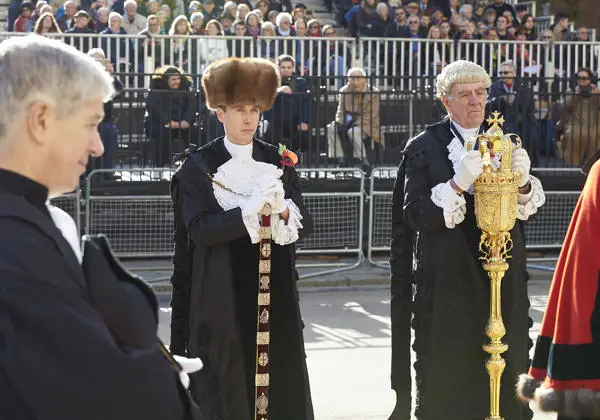Ceremonial
The three ceremonial officers are appointed by the Court of Aldermen.
Swordbearer of London
The office has been in existence since the 14th Century but is first distinctly mentioned in 1419 when issues about his job description came up. It was then recorded that the Lord Mayor should have, at his own expense, someone to bear his sword before him: ‘a man well-bred' (one who knows how in all places, in that which unto such service pertains, to support the honour of his Lord and of the City).
Common Cryer and Serjeant-at-Arms
The office of Common Cryer and Serjeant-at-Arms may be the oldest of the three ceremonial offices. The Common Cryer and Serjeant-at-Arms carries the Great Mace of Government before the Lord Mayor. The office was established well before 1338 when it was held by one of the King’s Serjeant-at-Arms. In 1419 the title held by the mace bearer was Common Serjeant-at-Arms of the City, otherwise called the Common Cryer. He had a salary of 60 shillings a year, robes, fees from the Alderman and Sheriffs and a ‘sufficient horse’ for the honour of the City. By 1559 the current title was in use.
City Marshal
The origin of the City Marshal can be found in letters patent of Queen Elizabeth I dated 1595 which gave powers to a marshal to maintain order in the City.
Subsequently, an Under-Marshal was appointed along with six Marshalmen. All were provided with horses. With the passing of the Police Acts of 1829 and 1839, many of the policing duties were removed from the marshals. Nevertheless, the City Marshal is still the Lord Mayor’s peacekeeper. As such he ‘clears the way’ by the marshalling of civic processions ‘and calls the names of the members thereof in their proper order.’ He also represents the Lord Mayor at all Entry of Troops. He challenges, then escorts those regiments (seven in 2008) honoured to be allowed to exercise their privilege to march through the City ‘with drums beating, bayonets fixed and colours flying.’
